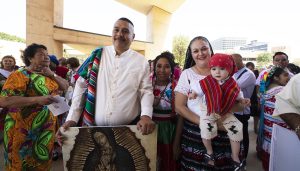According to a June 2021 study released by CARA (the standard when it comes to statistical analysis of the Church in the United States) based on 2,391 parishes in the United States, about a quarter say they serve at least one immigrant community. The most common communities mentioned were in Mexico (328), the Philippines (88), El Salvador (44), and Vietnam (40).
More than 21% of the parishes indicated that they have at least one Spanish weekend Mass, and 8% have a weekend Mass in a language other than English or Spanish. These included Vietnamese, Polish, Portuguese, Korean, Arabic, and Tagalog.
These are powerful reminders of the fact that we are a global Church. They are also deeply inconvenient facts for those who want to identify Catholicism with U.S. culture. Remember, our primary bonds are not as fellow citizens of the U.S., but as brothers and sisters in Christ. Or at least they should be.
Recall St. Paul’s insistence that there is no longer “Jew or Greek” but that all are one in Christ Jesus. Furthermore, moving with hope from one land to another — something that St. Paul knew very well in his own travels, obviously — is an important part of the Christian experience, from its earliest moments right through today.
Catholic immigrants from Europe in the latter half of the 19th century were willing to suffer terrible discrimination from an anti-Catholic culture in order to practice their faith. Their way of living — not fully immersed in their new country and not fully forgetful of their old countries — put them in a wonderful position to avoid the idolatry that too often accompanies our cultural status quo.

I’ve been extremely fortunate to experience this in my own life in my wife’s wonderful Filipino family and have seen first-generation immigrants live in this space in between the U.S. and Filipino cultures. Because of this, they are in a much better position than more established populations are to live out their faith — and it shows.
My Filipino relatives have inspired me on numerous occasions to live my faith in important ways when I would otherwise be captured by slothful, self-obsessed U.S.-style individualism. For example, Christmas in our family means a very holy, festive, a full (of food!) celebration of “Simbang Gabi,” and a nine-day series of Masses and prayers, fellowship, and meals leading up to Christmas Day. It’s easy to resist the mind-numbing consumerism of a typical American Christmas if we are living in the midst of this type of tradition and celebrating it as a tightknit Catholic community.
This is also true for many Latino communities that have similarly powerful devotional practices, particularly with Our Lady of Guadalupe, the Day of the Dead, Ash Wednesday, Holy Hour, and more. What an incredible gift Catholic immigrants give to the Church. They convict the comfortable establishment for living in idolatry — while at the same time offering alternatives and resources for resisting it.
An authentic Catholic faith, one that starts with our common baptism and commitment to the Gospel as our ultimate source of identity, must do everything it can to avoid an idolatrous acceptance of the values of a surrounding culture that is eating Catholic cultures alive.
This requires creating a robust Catholic counterculture in which we think of ourselves as pilgrims on a journey, never quite at home. It is, of course, good to love one’s country and will the good of its people, to do what we can to make the local and national order better reflect the Gospel.
But for Catholics (and all people of faith), it is deeply problematic to make “country” one’s highest good. Catholics must get comfortable with being uncomfortable foreigners in a land that is not truly their own. There is no more powerful example leading us in their direction than fellow Catholics who are immigrants to our shores.
How much more authentic to the Gospel could U.S. Catholics as a group be if we allowed our immigrant communities to move us even more in a politically complex (or even homeless!) direction? What if we truly reflected a Catholic vision on issues of life and family (sometimes called conservative) and a Catholic vision on issues of social justice (sometimes called liberal) in the way many Latino communities do? This would be the height of anti-idolatry, Gospel-centered politics.
This excerpt from “One Church: How to Rekindle Trust, Negotiate Difference, and Reclaim Catholic Unity” (Amazon, $17.95) by the author is reprinted with permission of the publisher, Ave Maria Press.

